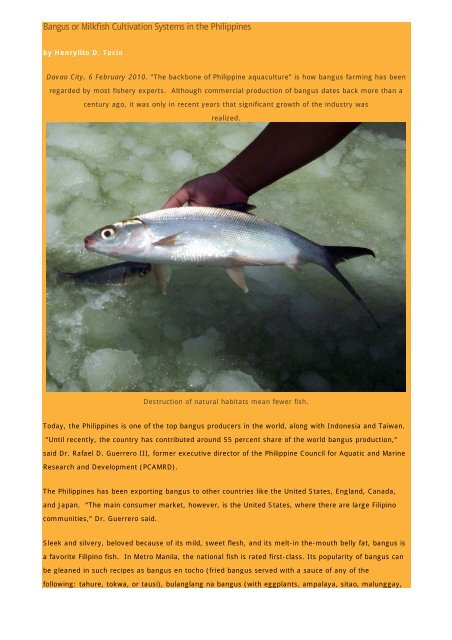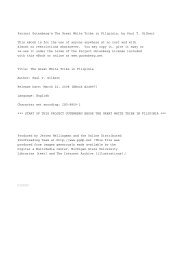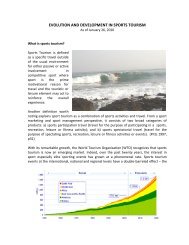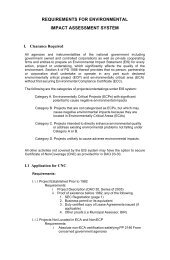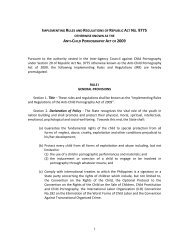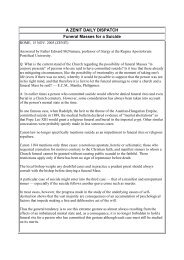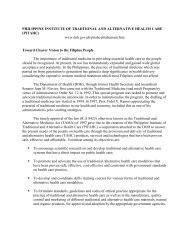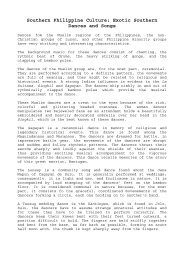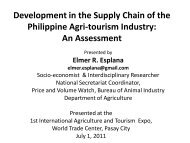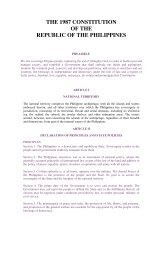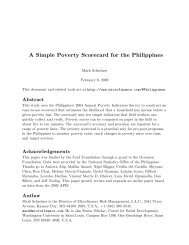Bangus or Milkfish Cultivation Systems in the Philippines
Bangus or Milkfish Cultivation Systems in the Philippines
Bangus or Milkfish Cultivation Systems in the Philippines
You also want an ePaper? Increase the reach of your titles
YUMPU automatically turns print PDFs into web optimized ePapers that Google loves.
<strong>Bangus</strong> <strong>or</strong> <strong>Milkfish</strong> <strong>Cultivation</strong> <strong>Systems</strong> <strong>in</strong> <strong>the</strong> Philipp<strong>in</strong>es<br />
by Henrylito D. Tacio<br />
Davao City, 6 February 2010. “The backbone of Philipp<strong>in</strong>e aquaculture” is how bangus farm<strong>in</strong>g has been<br />
regarded by most fishery experts. Although commercial production of bangus dates back m<strong>or</strong>e than a<br />
century ago, it was only <strong>in</strong> recent years that significant growth of <strong>the</strong> <strong>in</strong>dustry was<br />
realized.<br />
Destruction of natural habitats mean fewer fish.<br />
Today, <strong>the</strong> Philipp<strong>in</strong>es is one of <strong>the</strong> top bangus producers <strong>in</strong> <strong>the</strong> w<strong>or</strong>ld, along with Indonesia and Taiwan.<br />
“Until recently, <strong>the</strong> country has contributed around 55 percent share of <strong>the</strong> w<strong>or</strong>ld bangus production,”<br />
said Dr. Rafael D. Guerrero III, f<strong>or</strong>mer executive direct<strong>or</strong> of <strong>the</strong> Philipp<strong>in</strong>e Council f<strong>or</strong> Aquatic and Mar<strong>in</strong>e<br />
Research and Development (PCAMRD).<br />
The Philipp<strong>in</strong>es has been exp<strong>or</strong>t<strong>in</strong>g bangus to o<strong>the</strong>r countries like <strong>the</strong> United States, England, Canada,<br />
and Japan. “The ma<strong>in</strong> consumer market, however, is <strong>the</strong> United States, where <strong>the</strong>re are large Filip<strong>in</strong>o<br />
communities,” Dr. Guerrero said.<br />
Sleek and silvery, beloved because of its mild, sweet flesh, and its melt-<strong>in</strong> <strong>the</strong>-mouth belly fat, bangus is<br />
a fav<strong>or</strong>ite Filip<strong>in</strong>o fish. In Metro Manila, <strong>the</strong> national fish is rated first-class. Its popularity of bangus can<br />
be gleaned <strong>in</strong> such recipes as bangus en tocho (fried bangus served with a sauce of any of <strong>the</strong><br />
follow<strong>in</strong>g: tahure, tokwa, <strong>or</strong> tausi), bulanglang na bangus (with eggplants, ampalaya, sitao, malunggay,
onion, tomatoes, rice wash<strong>in</strong>g and bagoong), rellenong bangus (f<strong>or</strong>merly a party dish; now available<br />
even <strong>in</strong> school cafeterias), and bangus lumpia.<br />
Also known as milkfish, bangus (scientific name: Chanos chanos) is most closely related to carps and<br />
catfishes. It occurs <strong>in</strong> <strong>the</strong> Indian Ocean and across <strong>the</strong> Pacific Ocean, tend<strong>in</strong>g to school around coasts<br />
and islands with reefs. A warm water species, it prefers water temperatures between 20-33 degrees<br />
Centigrade.<br />
In <strong>the</strong> Philipp<strong>in</strong>es, bangus can be raised anywhere. However, <strong>the</strong> top bangus produc<strong>in</strong>g prov<strong>in</strong>ces are<br />
Bulacan, Pangas<strong>in</strong>an, Capiz, Iloilo, and Negros Occidental. The most recent rep<strong>or</strong>t released by <strong>the</strong><br />
Bureau of Agricultural Statistics (BAS) show that <strong>the</strong> comb<strong>in</strong>ed production of <strong>the</strong>se five prov<strong>in</strong>ces alone<br />
accounts f<strong>or</strong> m<strong>or</strong>e than 50 percent of <strong>the</strong> country’s total production.<br />
Rais<strong>in</strong>g bangus can be done employ<strong>in</strong>g different production systems <strong>in</strong> freshwater and <strong>in</strong><br />
brackishwater. “Depend<strong>in</strong>g on <strong>the</strong> available resources and level of management, <strong>the</strong> culture methods<br />
can vary from <strong>the</strong> traditional <strong>or</strong> extensive system, <strong>the</strong> modular <strong>or</strong> semi-<strong>in</strong>tensive to <strong>the</strong> <strong>in</strong>tensive<br />
system,” acc<strong>or</strong>d<strong>in</strong>g to <strong>Milkfish</strong>: A Basic Domestic Need Commodity, a primer published by PCAMRD.<br />
The semi-<strong>in</strong>tensive system is an improvement of <strong>the</strong> traditional system where f<strong>in</strong>gerl<strong>in</strong>gs are stocked at a<br />
higher density. With natural and artificial feeds, bangus f<strong>in</strong>gerl<strong>in</strong>gs are stocked at densities of 6,000 to<br />
12,000 per hectare. With dependence on natural food <strong>in</strong> <strong>the</strong> traditional system, low stock<strong>in</strong>g densities of<br />
1,000 to 3,000 f<strong>in</strong>gerl<strong>in</strong>gs per hectare are applied. In this method, <strong>the</strong> culture period is longer thus<br />
allow<strong>in</strong>g only one <strong>or</strong> two cropp<strong>in</strong>gs a year. The modular pond system, on <strong>the</strong> o<strong>the</strong>r hand, allows a<br />
cont<strong>in</strong>uous operation and makes possible four to six cropp<strong>in</strong>gs per year.<br />
To make fishponds and fish cages productive throughout <strong>the</strong> year, adequate supply of bangus f<strong>in</strong>gerl<strong>in</strong>gs<br />
is necessary. “Hist<strong>or</strong>ically, milkfish fry abound <strong>in</strong> <strong>the</strong> country, especially dur<strong>in</strong>g <strong>the</strong> fry season <strong>in</strong> <strong>the</strong><br />
months of April to October,” <strong>the</strong> PCAMRD primer rep<strong>or</strong>ts. “Dur<strong>in</strong>g recent years, <strong>the</strong> number collected has<br />
been dw<strong>in</strong>dl<strong>in</strong>g.”
Farmed f<strong>in</strong>gerl<strong>in</strong>gs are preferred to wild catch.<br />
Among <strong>the</strong> causes cited f<strong>or</strong> <strong>the</strong> dim<strong>in</strong>ish<strong>in</strong>g supply of bangus fry were destruction of natural habitats<br />
brought about by <strong>the</strong> extensive conversion of mangrove areas to fishponds, destructive fish<strong>in</strong>g methods<br />
and environmental degradation, among o<strong>the</strong>rs.<br />
“With <strong>the</strong> decrease <strong>in</strong> seed supply, <strong>the</strong> cost of fry and f<strong>in</strong>gerl<strong>in</strong>gs has <strong>in</strong>creased significantly over <strong>the</strong><br />
years,” <strong>the</strong> primer said. To save <strong>the</strong> bangus <strong>in</strong>dustry from downfall, some have imp<strong>or</strong>ted f<strong>in</strong>gerl<strong>in</strong>gs from<br />
Taiwan and Indonesia; although o<strong>the</strong>rs thought this option was not practical as <strong>the</strong> fry were very<br />
expensive.<br />
Enter F<strong>in</strong>fish Hatcheries, Inc. (FHI), which sell<strong>in</strong>g bangus fry and f<strong>in</strong>gerl<strong>in</strong>gs, among o<strong>the</strong>rs. “We<br />
have been <strong>in</strong> <strong>the</strong> bangus fry production bus<strong>in</strong>ess s<strong>in</strong>ce 1997,” says Rene B. Bocaya, FHI’s national<br />
market<strong>in</strong>g manager.<br />
Acc<strong>or</strong>d<strong>in</strong>g to Bocaya, <strong>the</strong> price per piece of wild bangus fry was P1.00 a decade <strong>or</strong> so ago. “With <strong>the</strong><br />
<strong>in</strong>troduction to <strong>the</strong> market of hatchery produced fry (local and imp<strong>or</strong>ted), <strong>the</strong> price now ranges from<br />
thirty to f<strong>or</strong>ty-five centavos per piece only. The hatchery-produced fry doesn’t only give very big sav<strong>in</strong>gs<br />
to <strong>the</strong> fishpond operat<strong>or</strong>s, but it also provides <strong>the</strong>m good quality and steady supply throughout <strong>the</strong> year.”<br />
As a result of steady supply of bangus <strong>in</strong> <strong>the</strong> market, <strong>the</strong>re are now process<strong>in</strong>g plants f<strong>or</strong> bangus valueadded<br />
products. The f<strong>or</strong>eign exchange earn<strong>in</strong>gs from bangus exp<strong>or</strong>ts has been rep<strong>or</strong>ted to be about<br />
US$15 million.
Intensive cultivation of bangus <strong>in</strong> <strong>the</strong> Philipp<strong>in</strong>es.<br />
In Sarangani Prov<strong>in</strong>ce, where <strong>the</strong> FHI’s hatchery is located, bangus production has <strong>in</strong>creased<br />
considerably. Actually, <strong>the</strong> hatchery is <strong>in</strong> Lun Masla, Malapatan. Here, about 13,000 breeders are<br />
ma<strong>in</strong>ta<strong>in</strong>ed and managed to produce bangus eggs on a daily basis throughout <strong>the</strong> year. The eggs are<br />
collected, cleaned and hatched. The hatchl<strong>in</strong>gs are grown to <strong>the</strong> marketable sizes <strong>in</strong> 18-21 days <strong>in</strong> larval<br />
ponds. Dur<strong>in</strong>g <strong>the</strong> grow<strong>in</strong>g period, <strong>the</strong>y are fed with a mixture of planktons and commercial feeds.<br />
The breeders are 50% males and 50% females. “It is tedious to sex <strong>the</strong> fish <strong>in</strong>dividually and tag <strong>the</strong>m,”<br />
Bocaya expla<strong>in</strong>s. “We have some breeders that are m<strong>or</strong>e than 25 years old and are still breed<strong>in</strong>g <strong>in</strong><br />
groups well.”<br />
It takes 5 years f<strong>or</strong> a bangus to mature sexually. FHI selects breeders f<strong>or</strong> commercial production only<br />
when <strong>the</strong>y are 8 years old. The female mature breeder, called sabalo, can produce seven kilos of eggs <strong>in</strong><br />
one year. And one kilo consists of 750,000 eggs.<br />
<strong>Bangus</strong> spawns <strong>in</strong> ponds <strong>in</strong> frenzy at night. The sabalo release <strong>the</strong> eggs while <strong>the</strong> males discharge <strong>the</strong><br />
milt. Fertilization happens externally <strong>in</strong> <strong>the</strong> pond water. There is no need f<strong>or</strong> h<strong>or</strong>mone <strong>in</strong>duction f<strong>or</strong><br />
mature breeders. The eggs are collected <strong>in</strong> nets <strong>in</strong> <strong>the</strong> early m<strong>or</strong>n<strong>in</strong>g. They are cleaned and placed <strong>in</strong> <strong>the</strong><br />
larval ponds immediately.
“The bangus eggs hatch <strong>in</strong> <strong>the</strong> ponds with<strong>in</strong> 24 hours,” Bocaya <strong>in</strong>f<strong>or</strong>ms. “The hatchl<strong>in</strong>gs feed on <strong>the</strong> yolk<br />
sac f<strong>or</strong> about 2-3 days. They undergo m<strong>or</strong>phological transf<strong>or</strong>mations. As first feeds, <strong>the</strong> larva are<br />
supplied natural food <strong>in</strong> a mixture of zoo- and phyto-planktons. Commercial feeds are provided <strong>in</strong> <strong>the</strong> last<br />
quarter of <strong>the</strong> production.”<br />
<strong>Bangus</strong> is grown <strong>in</strong> a number of stages and <strong>in</strong> vary<strong>in</strong>g degrees of culture <strong>in</strong>tensity depend<strong>in</strong>g on <strong>the</strong><br />
grower’s production design and <strong>the</strong> nature of <strong>the</strong> grow<strong>in</strong>g environment. The simplest bangus value cha<strong>in</strong><br />
is <strong>the</strong> three-stage system of a nursery stage, a transition stage and a grow-out stage.<br />
In <strong>the</strong> nursery, bangus is grown from fry (kawag-kawag) to f<strong>in</strong>gerl<strong>in</strong>g (hatir<strong>in</strong>). In <strong>the</strong> transition stage,<br />
<strong>the</strong> f<strong>in</strong>gerl<strong>in</strong>gs are grown to juvenile (garungan). In <strong>the</strong> grow-out stage <strong>the</strong> juveniles are grown to<br />
marketable sizes.<br />
In <strong>the</strong> grow-out stage, bangus is produced <strong>in</strong> a number of categ<strong>or</strong>ies depend<strong>in</strong>g on <strong>the</strong> pond structure<br />
<strong>the</strong> capitalization and <strong>the</strong> grower’s production design. Traditional extensive ponds us<strong>in</strong>g lablab as feeds<br />
n<strong>or</strong>mally seed 2,000 juveniles of 50 grams <strong>in</strong> size.Lablab production is takes 6 weeks. A wellprepared<br />
lablab pond can produce 500 kilograms of fish biomass. With 2,000 juveniles stocked, <strong>the</strong><br />
grower is able to produce 300-gram fish <strong>in</strong> three to four months from seed<strong>in</strong>g.<br />
<strong>Bangus</strong> grown <strong>in</strong> mar<strong>in</strong>e cage systems. In <strong>in</strong>tensive ponds with aeration, growers can produce 8,000-<br />
10,000 kilograms of bangus fish <strong>in</strong> a hectare. Stock<strong>in</strong>g density to grow 500-gram fish is about 20,000<br />
juveniles per hectare. In fish pens <strong>in</strong> Laguna Lake, juveniles of 30 to 50 grams are stocked at 50,000 per<br />
hectare. There is no feed<strong>in</strong>g needed as <strong>the</strong> lake provides <strong>the</strong> algae that <strong>the</strong> bangus feed on.
In mar<strong>in</strong>e sea cages, juveniles of 30 to 50 grams are stocked at a rate of 20-50 per square meter<br />
depend<strong>in</strong>g on <strong>the</strong> site and <strong>the</strong> bus<strong>in</strong>ess plan of <strong>the</strong> grower. Harvest can reach up to 30-40 kilograms per<br />
cubic meter of 500-gram bangus <strong>in</strong> six to eight months.<br />
Acc<strong>or</strong>d<strong>in</strong>g to Bocaya, at least 50 percent of <strong>the</strong> costs <strong>in</strong> <strong>in</strong>tensive pond systems goes to feeds. The o<strong>the</strong>r<br />
costs that figure are electricity, water, lab<strong>or</strong> and pond ma<strong>in</strong>tenance costs. In mar<strong>in</strong>e cage systems,<br />
feeds are 80 percent of <strong>the</strong> costs. In extensive systems, lablab production is still 40 percent of <strong>the</strong> costs.<br />
“On <strong>the</strong> average, gross profits are at about 25 to 30 percent of sell<strong>in</strong>g price on a good year across all<br />
production systems,” Bocaya po<strong>in</strong>ts out.<br />
No wonder, sales of hatchery-bred f<strong>in</strong>gerl<strong>in</strong>gs are <strong>in</strong>creas<strong>in</strong>g. When <strong>the</strong>y were new, <strong>the</strong> fish operat<strong>or</strong>s<br />
and growers were skeptical about us<strong>in</strong>g <strong>the</strong> hatchery-bred f<strong>in</strong>gerl<strong>in</strong>gs. They thought that those caught<br />
from <strong>the</strong> wild were m<strong>or</strong>e hardy.<br />
However, <strong>the</strong> perceptions of bangus farmers have changed, Bocaya said. They now prefer <strong>the</strong> hatcherybred<br />
f<strong>in</strong>gerl<strong>in</strong>gs because <strong>the</strong>y are m<strong>or</strong>e unif<strong>or</strong>m and <strong>the</strong>y also grow faster. Those from <strong>the</strong> wild usually<br />
have a survival rate of 50 to 60 percent while those from <strong>the</strong> hatchery usually have 82 to 85 percent<br />
survival rate.<br />
FHI now sells hatchery-bred f<strong>in</strong>gerl<strong>in</strong>gs all over <strong>the</strong> country. It delivers only when <strong>the</strong> m<strong>in</strong>imum volume<br />
of <strong>or</strong>der is 500,000 pieces. “Generally, <strong>the</strong> buyers pick-up <strong>the</strong> fry from our sales offices,” Bocaya<br />
says. Buyers can buy f<strong>in</strong>gerl<strong>in</strong>gs from <strong>the</strong>ir ma<strong>in</strong> sales office at 2286 Alsons Build<strong>in</strong>g, Pasong Tamo<br />
Extension <strong>in</strong> Makati City. They have offices also <strong>in</strong> Bacolod City, Iloilo City, and Alabel, Sarangani<br />
Prov<strong>in</strong>ce.<br />
Ref.: http://www.gaiadiscovery.com/mar<strong>in</strong>e-life-latest/bangus-<strong>or</strong>-milkfish-cultivation-systems-<strong>in</strong>-<strong>the</strong>-philipp<strong>in</strong>es.html


